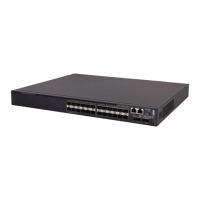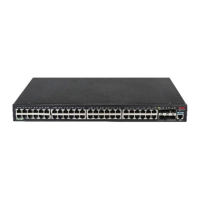318
Configuration procedure
In this approach, you configure a VLAN as an IPv6 multicast VLAN, and configure user VLANs as
sub-VLANs of the IPv6 multicast VLAN.
To configure a sub-VLAN-based IPv6 multicast VLAN:
Ste
Command
Remarks
1. Enter system view.
system-view N/A
2. Configure the specified VLAN
as an IPv6 multicast VLAN
and enter IPv6 multicast
VLAN view.
multicast-vlan ipv6 vlan-id
No IPv6 multicast VLAN
configured by default.
3. Configure the specified
VLANs as sub-VLANs of the
IPv6 multicast VLAN.
subvlan vlan-list
By default, an IPv6 multicast VLAN
has no sub-VLANs.
Configuring a port-based IPv6 multicast VLAN
When you configure a port-based IPv6 multicast VLAN, you need to configure the attributes of each user
port and then assign the ports to the IPv6 multicast VLAN.
A user port can be configured as a multicast VLAN port only if it is an Ethernet port or Layer 2 aggregate
interface.
In Ethernet interface view or Layer 2 aggregate interface view, configurations that you make are effective
only on the current interface. In port group view, configurations that you make are effective on all ports
in the current port group.
Configuration prerequisites
Before you configure a port-based IPv6 multicast VLAN, complete the following tasks:
• Enable IPv6 forwarding.
• Create VLANs as required.
• Enable MLD snooping in the VLAN to be configured as an IPv6 multicast VLAN.
• Enable MLD snooping in all the user VLANs.
Configuring user port attributes
First, configure the user ports as hybrid ports to permit packets of the specified user VLAN to pass and
configure the user VLAN to which the user ports belong as the default VLAN.
Then, configure the user ports to permit packets of the IPv6 multicast VLAN to pass and untag the packets.
After receiving multicast packets tagged with the IPv6 multicast VLAN ID from the upstream device, the
Layer 2 device untags the multicast packets and forwards them to its downstream device.

